Med Surg Templates - Template for med surg nursing students PDF

| Title | Med Surg Templates - Template for med surg nursing students |
|---|---|
| Author | Jourdanne Mostajo |
| Course | Advanced Med Surg |
| Institution | West Coast University |
| Pages | 14 |
| File Size | 934.1 KB |
| File Type | |
| Total Downloads | 90 |
| Total Views | 182 |
Summary
Template for med surg nursing students...
Description
ASSOCIATE DEGREE IN NURSING COURSE SYLLABUS Nsg 270 Complex Health Concepts
Jourdanne Mostajo Captopril
20
Angiotensin-converting enzyme inhibitors
Reduce production of angiotensin II by blocking the conversion of angiotensin I to angiotensin II and increasing levels of bradykinin, leading to vasodilation, excretion of sodium/water, and retention of potassium by actions in the kidneys
- hypertension - heart failure - MI - diabetic and non diabetic nephropathy
- first dose orthostatic hypotension - cough - hyperkalemia - rash and dysguesia (altered taste) - angioedema
- pregnancy risk category D during 2nd and 3rd trimester, related to fetal injury - contraindicated in clients with history of allergy to ACE inhibitors, single kidney, bilateral artery stenosis - caution in clients with kidney impairment
- diuretics can contribute to first-dose hypotension - antihypertensive medications can have an additive hypotensive effect - ACE inhibitors can increase levels of lithium - use of NSAIDs can decrease the antihypertensive effect of ace inhibitors
- decrease in blood pressure and maintenance of normotensive blood pressure - improvement of heart failure (ability to perform ADL, improved breath sounds, and absence of edema)
Nsg 270 Complex Health Concepts Revised 12/2020
Administer ACE inhibitors orally except enalaprilat, which is the once ACE inhibitor for IV use
- start treatment with a low dosage of the medication - monitor blood pressure for 2 hr after initiation of treatment - monitor potassium levels to maintain a level within the expected reference range - monitor manifestations of hyperkalemia
- change positions and lie down if feeling faint, lightheaded, and dizzy - inform clients of the possibility of experiencing dry cough and notify provider - inform provider if rash and altered taste occur. - rise slowly from stirring - report if pregnancy is suspected
Page 100 of 105
ASSOCIATE DEGREE IN NURSING COURSE SYLLABUS Nsg 270 Complex Health Concepts
Jourdanne Mostajo Paracentesis
47
A paracentesis is performed by inserting a needle or tripartite through the abdominal wall into the peritoneal cavity. Goal is reliefs of abdominal ascites pressure
Abdominal ascites - ascites is an abnormal accumulation of protein-rich fluid in the abdominal cavity most often caused by cirrhosis of the liver - respiratory distress is the determining factor in the use of a paracentesis to treat ascites, and in the evaluation of treatment effectiveness
Gastrointestinal therapeutic procedures nurses should be knowledgeable about include enteral feedings, TPN, abdominal paracentesis, NG decompression, bariatric surgeries, and ostomies
Hypovolemia: - albumin levels can drop because the peritoneal fluid removed contains a large amount of protein. The removal of this protein-rich fluid can cause shifting of intravascular volume, resulting in hypovolemia
Nsg 270 Complex Health Concepts Revised 12/2020
Pre: - determine readiness for procedure - assess pertinent blood testing results - verify consent signed Intra: - monitor VS - adhere standard precautions - label specimens and send to lab Post: - check VS and I&O
- local anesthetic s will be used at insertion site - there can be pressure or pain with needle insertion - avoid alcohol, maintain a low-sodium diet, and monitor the puncture site for bleeding or leakage fluid - change positions slowly to decrease risk of falls
- preventative measures include slow drainage of fluid and administration of plasma expanders (albumin) to counter albumin losses - monitor for evidence of hypovolemia (tachycardia, hypotension, pallor, diaphoresis, dizziness)
Page 98 of 105
ASSOCIATE DEGREE IN NURSING COURSE SYLLABUS Nsg 270 Complex Health Concepts
Jourdanne Mostajo Amputation
Amputation is the removal of a body part, most commonly an extremities
The level of the amputation is determined by the presence of adequate blood flow needed for healing
- traumatic injury: crashes, etc. - thermal injury: frostbite, burns, etc. - malignancy
- C-reactive protein (CRP): inflammatory marker is an indicator of infection. Level lower than 1.0= no infection and level >8.0 = severe infection
- percent postoperative complication - assess site for bleeding - monitor tissue perfusion - monitor for infections
Closed amputation: - most common, skin flap sutured over residual limb Open amputation: - active infection, skin flap not immediately closed
Nsg 270 Complex Health Concepts Revised 12/2020
69
Blood glucose monitoring, safety, quit smoking, exercise, foot care
- pain - hx of injury or disease process precipitating amputation - altered peripheral pulses - differences in temperature - wounds
- angiography - doppppler laser and ultrasonography studies - TcPO2 - ankle brachial index
- opioids to block pain signals to brain - NSAIDs may also be used for pain
- care for and wrap the residual limb, and perform limb strengthening exercises - properly apply and care for prosthesis
- certified prosthetic orthotics will fit client with prosthesis - PT - psychologist - social worker
- have client lay prince for 20-30 min several times day to prevent hip contractures - discourage prolonged sitting - practice exercised that will prevent contractures - stand using good posture with residual limb in extension to aid in balance
Flexion contractures - more likely with hip or knee joint following amputation - prevention includes ROP=M exercises - follow protocol on elevating residual limb on pillow
Page 102 of 105
ASSOCIATE DEGREE IN NURSING COURSE SYLLABUS Nsg 270 Complex Health Concepts
Jourdanne Mostajo 8
Alzheimer’s disease
Memory loss, problems with judgment, and changes in personality
No reversible type of dementia that develops over many years
- advanced age - chemical imbalances - family history of AD or down syndrome - genetic predisposition
- no specific lab test can definitively diagnose AD - several lab tests can rule out other causes of dementia - genetic test for presence of apolipoprotein can determine risk for AD
- assess cognitive status, memory, judgment, and personality changes - initiate bowel and bladder program based on set schedule
- encourage the client and family to participate in an AD support group - provide verbal and nonverbal ways for communicating
Nsg 270 Complex Health Concepts Revised 12/2020
Take care of mental and physical health by engaging in exercise and mental stimulation
- different for each client - no universal scaled for the stages and manifestations - early, mild, severe
- brain tissue examination upon death - MRI, CT, CAT scan, PET, EEG may be performed to rule out other possible causes of findings
Most medications attempt to target behavioral and emotional problems - antipsychotics, antidepressants, anxiolytics - temporarily slow the course of disease
- educate family/caregivers about illness, methods of care, medications, and adaptation of the home environment
- avoid overstimulation near patient. Keep noise and clutter to a minimum - social services and case managers for long term/ home management
Provide a safe environment - frequent monitoring/visual checks - keep client from stairs, elevators, exits - remove or secure dangerous items in the client’s environment - provide frequent walks to reduce wandering
- losing/ misplacing items - wandering behavior - decreases ability to plan - can get lost while driving - unable to recall personal history - increased episodes of urinary and fecal incontinence - memory difficulties continue to worsen
Page 102 of 105
ASSOCIATE DEGREE IN NURSING COURSE SYLLABUS Nsg 270 Complex Health Concepts
Jourdanne Mostajo 78
Hyperthyroidism
Because thyroid activity affects all body systems, excessive thyroid hormone exaggerates normal body functions
Clinical syndrome caused by excessive circulating thyroid hormones
Take medicine with the same food or drink each day and don’t stop taking medicine
- Graves’ disease - thyroiditis - toxic adenoma - toxic modular goiter - exogenous hyperthyroidism
- nervousness, irritability, hyperactivity, emotional lability, decreased attention span - muscle weakness - heat intolerance - frequent stools/diarrhea
- blood TSH level - free t4 index, t4 (total) t3 - thyroid stimulating immunoglobulins - thyrotropin receptor antibodies
- ultrasound: produce images of thyroid gland - ECG: evaluates effects of excessive thyroid hormone - thyroid scan: nuclear medicine test
- minimize clients energy expenditure by assisting with activities and encouraging rest - monitor I&O
- radioactive iodine therapy: destroys hormone producing cells - thyroidectomy: surgical removal of gland, could be total or partial
Nsg 270 Complex Health Concepts Revised 12/2020
- thionamides: inhibit production of thyroid hormone - betaadrenergic blockers: counteract effects of increased thyroid hormone - iodine solution: short term
- take medication with meals - report fever, sore throat, jaundice, or bruising to provider
Am endocrinologist, radiologist, pharmacist, and dietician can collaborate in providing care for the client
- maintain seizure precautions - monitor nutritional status: provide increased calories, protein, and other nutritional support as necessary - monitor vital signs and hemodynamic parameters - reduce room temperature - monitor ecg for dysrhythmias
- hemorrhage: due to loosened surgical tie, excessive coughing, or movement, this can occur at incision or in the tissues, leading to respiratory distress - thyroid storm/ crisis: sudden large amounts of thyroid hormones in the bloodstream
Page 102 of 105
ASSOCIATE DEGREE IN NURSING COURSE SYLLABUS Nsg 270 Complex Health Concepts
Jourdanne Mostajo Electrocardiography
28
Cardiac electrical activity can be monitored by using an ECG. The heart’s electrical activity can be monitored by a standard 12-lead ECG, ambulatory ECG, continuous cardiac monitoring, or by telemetry
Dysrhymias: - sinus bradycardia and tachycardia - AV blocks - atrial fibrillation - ventricular asystole - premature atrial complexes and premature ventricular complexes - supraventricular tachycardia - ventricular tachycardia - ventricular fibrillation
Normal test results include: Heart rate: 60 to 100 beats per minute Heart rhythm: Consistent and even Abnormal ECG results may be a sign of: Damage or changes to the heart muscle Congenital heart defect Enlargement of the heart Fluid or swelling in the sac around the heart Inflammation of the heart (myocarditis) Past or current heart attack Poor blood supply to the heart arteries Abnormal heart rhythms (arrhythmias)
no risk of getting an electrical shock during the test because the electrodes placed on your body don't emit electricity. They only record the electrical activity of your heart.
Preprocedure: - prepare client for 12 lead ECG - position in supine, remove oils, clip hair Intraprocedure: - monitor for manifestations of dysrhythmia Postprocedure: - remove leads, print ECG report, notify provider - apply holster monitor
- No special preparations are necessary for a standard ECG. - tell your doctor about any medications and supplements you're taking because some can affect the results of your test. - Avoid drinking cold water or exercising before your EKG. - Drinking cold water can cause changes in the electrical patterns
Some people may experience a skin rash where electrodes were placed, but this usually goes away without treatment.
You may have minor discomfort, similar to removing a bandage, when the electrodes are removed.
Nsg 270 Complex Health Concepts Revised 12/2020
Page 99 of 105
ASSOCIATE DEGREE IN NURSING COURSE SYLLABUS Nsg 270 Complex Health Concepts
APPENDIX H THREE CRITICAL AREAS ATI PRACTICE ASSESSMENT
NAME
Jourdanne Mostajo
DATE:
11/18/21
1. Paracentesis, or abdominal tapping, is a procedure to remove excess fluid from the area between the abdominal wall and the spine. This area is known as the abdominal cavity. Excess fluid in the abdomen is called ascites. Usually, there should be no fluid within the abdominal cavity. Fluid in the abdominal cavity can cause bloating, pain, and breathing difficulties. Paracentesis helps remove fluid from the abdominal cavity. It can also be used to help a doctor determine the cause of the fluid buildup. Risks associated with paracentesis are rare, but the most common risks are minor trouble breathing and fluid leakage right after the procedure. Usually, you’ll have to wait to leave the doctor’s office or hospital until those clear up. Certain risk factors may also increase the chances of complications, especially if you have cirrhosis. You may also be more likely to develop an infection if you smoke or misuse alcohol on a regular basis. Poor nutrition can also increase the risk of infection.
2. ACE inhibitors are well-tolerated by most individuals. Nevertheless, they are not free of side effects, and some patients should not use ACE inhibitors. ACE inhibitors usually are not prescribed for pregnant women because they may cause birth defects. Individuals with bilateral renal artery stenosis (narrowing of the arteries that supply the kidneys) may experience worsening of kidney function, and people who have had a severe reaction to ACE inhibitors probably should avoid them. ACE inhibitors are very similar. However, they differ in how they are eliminated from the body and their doses. Some ACE inhibitors remain in the body longer than others, and are given once a day. Some ACE inhibitors need to be converted into an active form in the body before they work. In addition, some ACE inhibitors may work more on ACE that is found in tissues than on ACE that is present in the blood. The importance of this difference or whether one ACE inhibitor is better than another has not been determined.
3. A stress test, also known as an exercise test or treadmill test, can give an idea of how well a person’s heart works during physical activity. It can also help diagnose various heart conditions. A stress test typically involves walking on a treadmill or using a stationary cycle while medical devices monitor breathing, blood pressure, heart rate, and heart rhythm. Some people, such as those with arthritis, may not be able to do the activities involved in an exercise stress test. Instead, a doctor will give these people a drug to make their heart work harder, as it might during exercise. Stress tests can help a doctor diagnose various heart conditions. They can also help identify a person’s risk before undergoing an activity that may put strain on their heart and show how well a person’s heart handles a workload. When the heart pumps harder during exercise, the stress test can reveal issues such as low blood supply through the coronary arteries. These problems might not be apparent at other times.
Nsg 270 Complex Health Concepts Revised 12/2020
Page 97 of 105
Individual Performance Profile RN Adult Medical Surgical 2019 Individual Name: JOURDANNE M MOSTAJO
Adjusted Individual Total Score:
66.7%
Student Number:
ATI Proficiency Level: National Mean: Program Mean:
Level 1
Institution:
CNI College ADN
Program Type:
ADN
Test Date:
11/17/2021
69.2% 69.2% 39
National Percentile Rank: Program Percentile Rank:
38
Individual Performance in the Major Content Areas #
Individual
Points
Score
Management of Care
6
100.0%
78.8%
79.3%
99
99
Safety and Infection Control
8
62.5%
69.7%
70.7%
44
42
Health Promotion and Maintenance
4
100.0%
N/A
N/A
N/A
N/A
Psychosocial Integrity
3
33.3%
N/A
N/A
N/A
N/A
Basic Care and Comfort
8
62.5%
68.1%
68.4%
48
47
Pharmacological and Parenteral Therapies
16
75.0%
73.2%
73.6%
59
58
Reduction of Risk Potential
19
57.9%
71.8%
71.5%
20
20
Physiological Adaptation
26
61.5%
63.5%
63.0%
48
49
Sub-Scale
Mean National
Percentile Rank
Program Type
National
Individual Score (% Correct)
Program Type
NOTE: N/A indicates where means and percentile ranks are not presented for sub-scales with fewer than five items.
Topics To Review Go to your Improve tab to access your Focused Review Experience Safety and Infection Control (3 items) Accident/Error/Injury Prevention (1 item) Spinal Cord Injury: Care of a Client Who Has a Halo Device (RM AMS RN 11.0 Chp 16 Spinal Cord Injury,Active Learning Template: Therapeutic Procedure) Handling Hazardous and Infectious Materials (1 item) Cancer Treatment Options: Caring for a Client Who Is Receiving Brachytherapy (RM AMS RN 11.0 Chp 91 Cancer Treatment Options,Active Learning Template: Therapeutic Procedure) Standard Precautions/Transmission-Based Precautions/Surgical Asepsis (1 item) Gastrointestinal Diagnostic Procedures: Plan of Care for a Client Who Has Gastroenteritis (RM AMS RN 11.0 Chp 46 Gastrointestinal Diagnostic Procedures,Active Learning Template: System Disorder)
Psychosocial Integrity (2 items) Coping Mechanisms (1 item) Amputations: Providing Support Following an Alteration in Body Image (RM AMS RN 11.0 Chp 69 Amputations,Active Learning Template: Therapeutic Procedure) Support Systems (1 item) Please see page 7 for an explanation of the Scores and Topics to Review sections
Report Created on: 11/21/2021 10:23 PM EST
Page 1 of 7
REP_COMP_3_0_IndividualProctored_3_0_V3
Topics To Review Go to your Improve tab to access your Focused Review Experience Alzheimer's Disease: Providing a Family With Home-Care Instructions (RM AMS RN 11.0 Chp 8 Alzheimer's Disease,Active Learning Template: System Disorder)
Basic Care and Comfort (3 items) Elimination (1 item) Disorders of the Eye: Priority Action for Eye Irrigation (RM AMS RN 11.0 Chp 12 Disorders of the Eye,Active Learning Template: Therapeutic Procedure) Mobility/Immobility (1 item) Postoperative Nursing Care: Preventing Complications (RM AMS RN 11.0 Chp 96 Postoperative Nursing Care,Active Learning Template: Basic Concept) Nutrition and Oral Hydration (1 item) Heart Failure and Pulmonary Edema: Dietary Teaching About Sodium Restrictions (RM AMS RN 11.0 Chp 32 Heart Failure and Pulmonary Edema,Active Learning Template: System Disorder)
Similar Free PDFs

ATI MED SURG Notes FOR Nursing
- 33 Pages
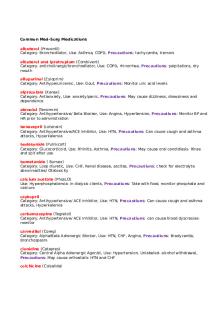
Common Med Surg Meds
- 7 Pages

Med surg dorris bowman
- 4 Pages
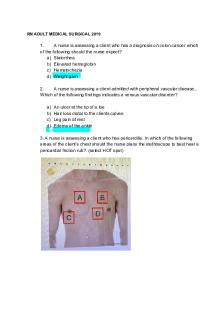
Med surg - notes
- 28 Pages
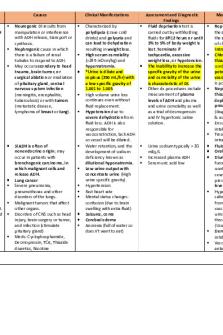
Med-Surg Endocrine
- 11 Pages
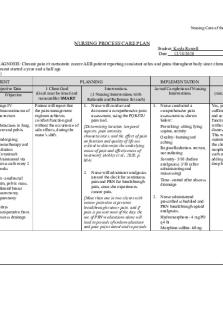
Med Surg- Care Plan
- 6 Pages
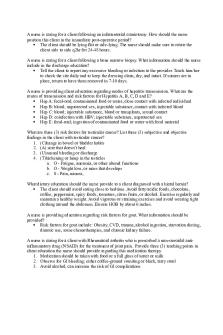
Med-Surg Capstone remediation
- 4 Pages

Med Surg Exam 3
- 19 Pages
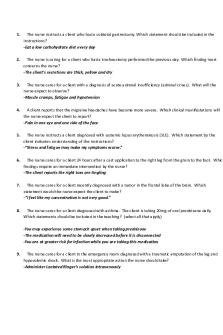
Kaplan med surg 2
- 8 Pages

Med surg 1
- 33 Pages

med surg review questions
- 7 Pages

Adv med surg remediation
- 2 Pages
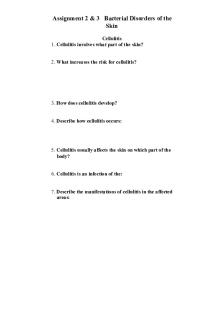
Med SURG; assignment 2
- 9 Pages
Popular Institutions
- Tinajero National High School - Annex
- Politeknik Caltex Riau
- Yokohama City University
- SGT University
- University of Al-Qadisiyah
- Divine Word College of Vigan
- Techniek College Rotterdam
- Universidade de Santiago
- Universiti Teknologi MARA Cawangan Johor Kampus Pasir Gudang
- Poltekkes Kemenkes Yogyakarta
- Baguio City National High School
- Colegio san marcos
- preparatoria uno
- Centro de Bachillerato Tecnológico Industrial y de Servicios No. 107
- Dalian Maritime University
- Quang Trung Secondary School
- Colegio Tecnológico en Informática
- Corporación Regional de Educación Superior
- Grupo CEDVA
- Dar Al Uloom University
- Centro de Estudios Preuniversitarios de la Universidad Nacional de Ingeniería
- 上智大学
- Aakash International School, Nuna Majara
- San Felipe Neri Catholic School
- Kang Chiao International School - New Taipei City
- Misamis Occidental National High School
- Institución Educativa Escuela Normal Juan Ladrilleros
- Kolehiyo ng Pantukan
- Batanes State College
- Instituto Continental
- Sekolah Menengah Kejuruan Kesehatan Kaltara (Tarakan)
- Colegio de La Inmaculada Concepcion - Cebu


